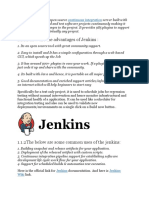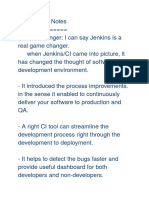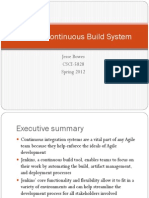0% found this document useful (0 votes)
143 views2 pagesJenkins Tutorial
The Jenkins Tutorial provides comprehensive guidance for both beginners and professionals on Jenkins, an open-source automation tool for continuous integration written in Java. It covers essential concepts such as installation, configuration, and pipeline creation, enabling organizations to automate software development processes and integrate various DevOps stages through plugins. Jenkins facilitates faster software development by continuously building, testing, and delivering projects, allowing developers to identify errors early in the development cycle.
Uploaded by
Rahul rahulCopyright
© © All Rights Reserved
We take content rights seriously. If you suspect this is your content, claim it here.
Available Formats
Download as DOCX, PDF, TXT or read online on Scribd
0% found this document useful (0 votes)
143 views2 pagesJenkins Tutorial
The Jenkins Tutorial provides comprehensive guidance for both beginners and professionals on Jenkins, an open-source automation tool for continuous integration written in Java. It covers essential concepts such as installation, configuration, and pipeline creation, enabling organizations to automate software development processes and integrate various DevOps stages through plugins. Jenkins facilitates faster software development by continuously building, testing, and delivering projects, allowing developers to identify errors early in the development cycle.
Uploaded by
Rahul rahulCopyright
© © All Rights Reserved
We take content rights seriously. If you suspect this is your content, claim it here.
Available Formats
Download as DOCX, PDF, TXT or read online on Scribd
/ 2




















































